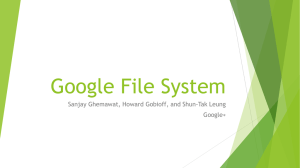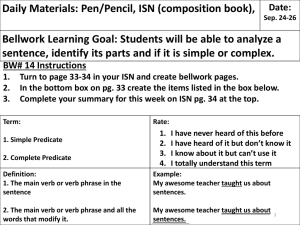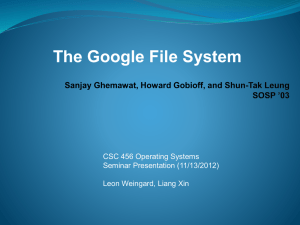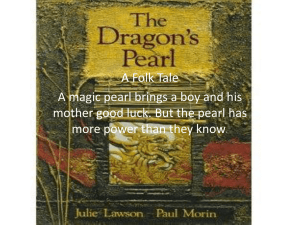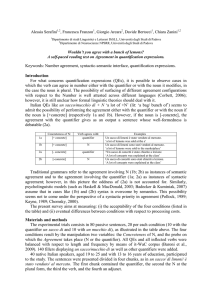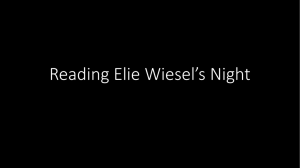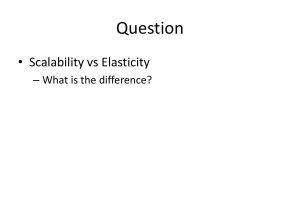Chunking Presentation
advertisement
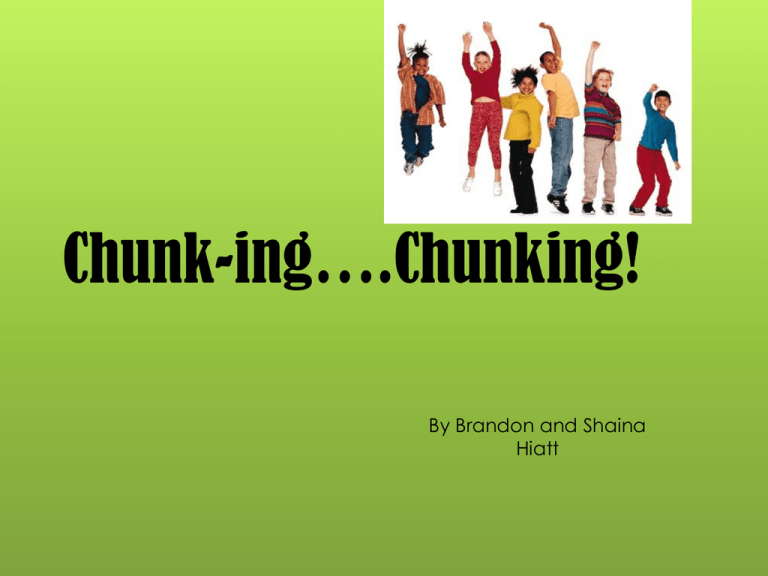
Chunk-ing….Chunking! By Brandon and Shaina Hiatt Let’s start off with a practice! (Please get out a writing utensil and paper) Chunk that word! http://www.starfall.com/n/skills/chunkin g/load.htm?f Now please briefly discuss with your neighbor some ideas of how this activity can be beneficial in your classroom? Thoughts we had? *Get them engaged *Open activity/attention getter *Reaches multiple learning intelligences *Can even add in hands on kinesthetics What is chunking? To “chunk” is to find similar parts in a word. This is helpful to students because the word parts are meaningful and can usually be easily announced. The parts could be sounds, prefixes, suffixes, endings, whole words, or base words. What kind of word parts are there? *Compound Words: two words that come together to form a new word. *Onsets: consonants that come before the vowel in a syllable or word. *Rimes: the vowel and all the consonants that come after it in a syllable or word until the next vowel. *Prefixes: any syllable at the beginning of a word that changes the meaning of that word. *Suffixes: any syllable with meaning at the end of a word that changes the meaning of that word. *Inflectional Endings: a special set of suffixes that change the number, case, or gender when added to nouns or tense when added to verbs. When teaching chunking: 1) First, try to read the unfamiliar word by looking for chunks. Ex. church 2) Next, read each chunk by itself. Ex:“ch” / “ur” / “ch” 3) Then, blend the chunks together and sound out the word. Ex: ch ur ch / church 4) Finally, have the students reflect, “Does that word make sense in the context?” or “Does that word match the picture?” 3 exceptions in chunking! The Main Rule Stop each chunk after the vowel sound and use the first vowel sound on the first attempt to decode an unfamiliar word. Obviously, if your child is familiar with the word, he/she should use the correct vowel sound in each chunk, but if he/she is not, then, he/she should be trained to try the first vowel sound on the initial attempt. The First Exception If the next chunk starts with a doubled consonant, add it to the chunk before it. Explain that a doubled consonant is just a consonant letter that is repeated, giving examples like bb, dd, tt, etc The Second Exception If the next chunk is "hard to say," move a letter to the chunk before it. The second exception utilizes the concept of an illegal English blend. We only start words with certain consonant combinations, or blends, and there aren't a lot of them so most children readily recognize them. Thus, words can start with "bl" (black) or "br" (brick) but not "bc," "bd," "bf," bg," etc. Similar situations exist for all the consonants used to begin words. The words beginning with "s" have several more legal options ("sc," "scr," "sk," "sl," "sm," "sn," "sp," "spl," "spr," "st," "str," and "sw") but that's about as complex as it gets. Again, most children have an inherent understanding of legal English blends because they are always using them when speaking. The Third Exception If the next chunk starts with a marker, move it to the chunk before it. The third exception utilizes the concept of a marker. When you taught the phonograms "x," "ck," "tch," and "dge," you called them all markers. Now, you again explain that a marker always follows a single vowel letter and that it "marks" the sound of that letter as the first vowel sound. You should add that markers are never found at the beginning of words, and that they should not begin a chunk either. http://www.ontrackreading.com/spalding-method/chunking-multisyllable-words Why chunking Works? *In order for children to comprehend what they read, they must first learn to decode the text *Students have an easier time decoding if they first learn to segment words by chunks. *Children can better decode words if they sound them out in chunks as opposed to letter by letter. *According to Margaret Moustafa (1997): “Children are able to analyze spoken words into onsets and rimes before they are able to analyze spoken words into phonemes when onsets and rimes consist of more than one phoneme. If students learn to decode by "chunking" as opposed to sounding out each letter of a word, they will acquire a greater vocabulary. *According to Adams, "Nearly five hundred common words can be derived from only thirty-seven rimes." (Adams, 1990 in Routman, 2000, p. 102). Reference - Routman, R. (2000). Conversations. New Hampshire: Heinemann. http://www.proteacher.net/discussions/showthread.php?t=80102 Chunk It Teaching Segmenting & Blending as a Reading Strategy Jack Hartmann Chorus: Chunk the beginning, chunk it at the end Chunk it in the middle or anyway you can If you can’t read a word and you don’t know what to do Chunk, chunk, chunk it and it might help you Chunk the word "chin" Chunk the beginning ch ch Chunk it at the end in in Put the chunk together ch-in, ch-in And you’ve go "chin" Let’s chunk the word "rainbow" Chunk the beginning rain rain Chunk it at the end bow bow Put the chunks together rain bow, rain bow And you’ve got "rainbow" Repeat Chorus Let’s chunk the word "anteaters" Chunk the beginning ant ant Chunk the middle eat eat Chunk the end ers ers Put the chunks together ant eat ers And you’ve got anteaters Repeat Chorus Let’s chunk the word "_________" Chunk the beginning ___ ___ Chunk the middle ___ ___ Chunk the end ___ ___ Put the chunks together ___ ___ ___ And you’ve got "_________" References “Chunking Multisyllable Words” http://www.ontrackreading.com/spalding-method/chunking-multisyllable-words “Chunking Verses Sounding-out Words” http://www.proteacher.net/discussions/showthread.php?t=80102 “Chunk That Word’ Chicken song http://www.starfall.com/n/skills/chunking/load.htm?f “Chunk It” Teaching Segmenting & Blending as a Reading Strategy by Jack Hartmann http://www.songsforteaching.com/jackhartmann/chunkingreadingstrategy.htm “2-Syllable Chunking Explained” http://www.ontrackreading.com/phonics-program/2-syllable-chunking-explained *Pictures of children and music notes were found at www.googleimages.com

